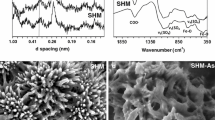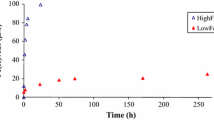Abstract
The formation of fine-grained magnetite (~0.1 μm) at pH 7 and 25°C from aeration of Fe(II) chloride solutions is presented. The magnetite converted at 105°C to maghemite with poorly developed superstructure lines. Under the experimental conditions employed, as the initial [Cl]/[Fe] ratio was increased from the stoichiometric value of 2, the final product contained increasing amounts of lepidocrocite. The degree of crystallinity of this phase, as measured by the width at half height of the 020 X-ray diffraction peak, also increased with this ratio. The hydrolysis rate (base consumption to maintain pH) showed a plateau whose position and extent changed with the initial [Cl]/[Fe] ratio. Through this plateau region the Eh decreased to a minimum value the position of which was directly related to the [Cl]/[Fe] value. The formation of lepidocrocite rather than magnetite is likely due to the high [Cl] where there would be increased difficulty for neighboring OH to condense and eliminate H2O. The formation of Fe-O-Fe bonds in this condensation would be impeded by Cl substitution for OH either in the first formed green rust stage or during its oxidation.
Резюме
Представлено образование мелкозернистого магнетита (~0,1 μm) при pH = 7 и 25°С путем аэрации растворов Fe(II) хлорида. Магнетит превращался при 105°С в магемит с недоразвитыми линиями суперструктуры. В условиях этого эксперимента, с увеличением начального отношения [Cl]/ [Fe] от стехиометрического значения 2, конечный продукт содержал увеличивающиеся количества лепидокрокита. Степень кристалличности этой фазы, измеренная по ширине на половине высоты линии 020 рентгеновской порошковой дифракции, также увеличивалась с увеличением этого отношения. Скорость гидролиза (расход щелочи для поддержания pH) показала плато, положение и размер которого изменялись с величиной отношения [Cl]/[Fe]. На протяжении этого района (плато), величина Eh уменьшалась до минимального значения в определенном месте, положение которого непосредственно зависило от величины отношения [Cl]/[Fe]. Образование скорее лепидокрокита, чем магнетита явдялось, вероятно, следствием высокого значения [Cl]. В этом случае имеются увеличенные трудности для конденсации соседних ОН и исключения Н2O, что способствует образованию связи Fe-O-Fe вследствие замещения ОН ионами Cl либо в стадии образованной в начале зеленой ржавчины, либо в течение ее окисления. [E.G.]
Resümee
Es wird die Bildung von feinkörnigem Magnetit (~0,1 μm) bei pH 7 und 25°C durch Durchlüftung von Fe(II)-Chloridlösungen beschrieben. Der Magnetit wandelte sich bei 105°C in Maghemit mit schlecht entwickelten Oberstrukturlinien um. Unter den gegebenen experimentellen Bedingungen enthielt das Endprodukt—da das ursprüngliche [Cl]/[Fe]-Verhältnis höher war als der stöchiometrische Wert von 2—zunehmende Gehalte an Lepidokrokit. Der Kristallinitätsgrad dieser Phase nahm ebenfalls mit zunehmendem Verhältnis zu, wie aus der Breite bei halber Höhe des 020 Röntgendiffraktionspeaks hervorgeht. Die Hydrolysegeschwindigkeit zeigte ein Plateau, dessen Lage und Ausmaß sich mit dem ursprünglichen [Cl]/[Fe]-Verhältnis veränderte. Innerhalb dieses Plateaus nahm der Eh-Wert auf einen Mindestwert ab, dessen Lage direkt mit dem [Cl]/[Fe]-Wert zusammenhing. Die Bildung von Lepidokrokit vor Magnetit ist wahrscheinlich vom hohen [Cl]-Wert abhängig, wodurch es für benachbarte (OH)-Gruppen schwieriger ist zu kondensieren und H2O auszuschalten. Eine derartige Reaktion kann Fe-O-Fe-Bindungen hervorrufen, was auf der Substitution von Cl für OH, entweder im zuerst gebildeten grünen Rost oder während seiner Oxidation, beruht. [U.W.]
Résumé
On présente la formation de magnétite à fins grains (~ 0.1 μm) au pH 7 et à 25°C à partir de l’aération de solutions de chloride Fe(II). La magnetite s’est convertie à 105°C en maghémite avec des lignes superstructurales pauvrement developpées. Sous les conditions expérimentales employées, le produit final contenait de plus en plus grandes quantités de lépidocrite à fur et à mesure que la proportion initiale [Cl]/[Fe] a été augmentée à partir de la valeur stoichiométrique 2. Le degré de cristallinité de cette phase, mesuré à la largeur de la demi-hauteur du sommet de diffraction des rayons-X 020, a également augmenté proportionnellement à cette augmentation. Le taux d’hydrolyse (consommation de base pour maintenir le pH) a montré un plateau dont la position et l’étendue ont changé selon la proportion initiale [Cl]/[Fe]. A travers cette région de plateau, l’Eh a diminué à une valeur minimum dont la position était directement apparentée à la valeur [Cl]/[Fe]. La formation de lépidocrite plutôt que de magnétite est sans doute due au haut [Cl] òu il y avait d’avantage de difficulté pour l’OH avoisinant de se condenser et d’éliminer H2O. Une telle réaction provoquerait la formation de liens Fe-O-Fe à cause de la substitution de Cl pour OH soit dans l’étape de rouille verte formée d’abord, ou pendant son oxidation. [D.J.]
Similar content being viewed by others
References
Bernal, J. D., Dasgupta, D. R., and Mackay, A. L. (1959) The oxides and hydroxides of iron and their structural interrelationships: Clay Min. Bull. 4, 15–30.
Chittleborough, D. J., Walker, P. H., and Oades, J. M. (1983) Textural differentiation in chronosequences from eastern Australia. Part 1. Description, chemical properties and mi-cromorphology of soils: Geoderma. 32 (in press).
Detournay, J., Derie, R., and Ghodsi, M. (1976) Etude de l'oxydation par aeration de Fe(OH)2 en milieu chlorure: Z. Anorg. Allg. Chemie 427, 265–273.
Farrell, D. M. (1972) Infrared absorption in the oxidation of magnetite to maghemite and hematite: Can. Mines Br. Invest. Rep. IR 72-118, 44 pp.
Feitknecht, W. and Keller, G. (1950) Über Hydroxyde und basische Salze des 2 wertigen Eisens und deren dunkelgrüne Oxydationsprodukte: Z. Anorg. Chemie 262, 61–68.
Hamada, S. and Kuma, K. (1976) Preparation of γ-FeOOH by aerial oxidation of iron (II) chloride solution: Bull. Chem. Soc. Japan 49, 3695–3696.
Kiyama, M. and Takada, T. (1972) Iron compounds formed by aerial oxidation of ferrous salt solutions: Bull. Chem. Soc. Japan 45, 1923–1924.
Krause, A. and Borkowska, A. (1963) Der Einfluss von Fremdenanionen und die Struktur der Oxydationsprodukte: Z. Anorg. Allg. Chemie 326, 216–224.
Misawa, T., Hashimoto, K., and Shimodaira, S. (1974) The mechanism of formation of iron oxide and oxyhydroxides in aqueous solutions at room temperature: Corros. Sci. 14, 131–149.
Schwertmann, U. (1959) Mineralogische und chemische Untersuchungen an Eisenoxyden in Böden und Sedimenten: Neues Jb. Miner. 93, 67–86.
Stumm, W. and Lee, G. F. (1961) Oxygenation of ferrous iron: Ind. Eng. Chem. 15, 143–146.
Taylor, R. M. (1980) Formation and properties of Fe(II)Fe(III) hydroxy-carbonate and its possible significance in soil formation: Clay Miner. 15, 369–382.
Taylor, R. M. and McKenzie, R. M. (1980) The influence of aluminum on iron oxides. VI. The formation of Fe(II)-Al(III) hydroxy-chlorides, -sulfates, and -carbonates as new members of the pyroaurite group and their significance in soils: Clays & Clay Minerals 28, 178–187.
Taylor, R. M. and Schwertmann, U. (1974) Maghemite in soils and its origin. II. Maghemite synthesis at ambient temperature and pH 7: Clay Miner. 10, 299–310.
Taylor, R. M. and Schwertmann, U. (1978) The influence of Al on iron oxides. I. The influence of Al on Fe oxide formation from the Fe(II) system: Clays & Clay Minerals 26, 373–383.
Author information
Authors and Affiliations
Rights and permissions
About this article
Cite this article
Taylor, R.M. Influence of Chloride on the Formation of Iron Oxides From Fe(II) Chloride. I. Effect of [Cl]/[Fe] on the Formation of Magnetite. Clays Clay Miner. 32, 167–174 (1984). https://doi.org/10.1346/CCMN.1984.0320302
Received:
Accepted:
Published:
Issue Date:
DOI: https://doi.org/10.1346/CCMN.1984.0320302




